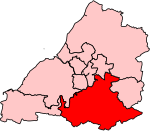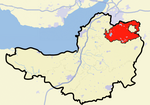High Littleton
Civil parishes in SomersetSomerset coalfieldUse British English from July 2012Villages in Bath and North East Somerset

High Littleton is a village and civil parish in Somerset, England, about 1.2 miles (1.9 km) north of Paulton and 7.5 miles (12 km) south-west of Bath. The parish includes the small village of Hallatrow and the hamlets of White Cross, Greyfield and Mearns; the northeastern part of High Littleton village is known as Rotcombe. High Littleton and Hallatrow are on the A39 Wells-Bath road, which is crossed by the A37 Shepton Mallet to Bristol road at White Cross. There is a Church of England Voluntary Controlled primary school (4–11 years) in the village, together with several pubs and shops.
Excerpt from the Wikipedia article High Littleton (License: CC BY-SA 3.0, Authors, Images).High Littleton
High Street, Bristol
Geographical coordinates (GPS) Address Website Nearby Places Show on map
Geographical coordinates (GPS)
| Latitude | Longitude |
|---|---|
| N 51.324 ° | E -2.511 ° |
Address
Spar
High Street
BS39 6JD Bristol
England, United Kingdom
Open on Google Maps








